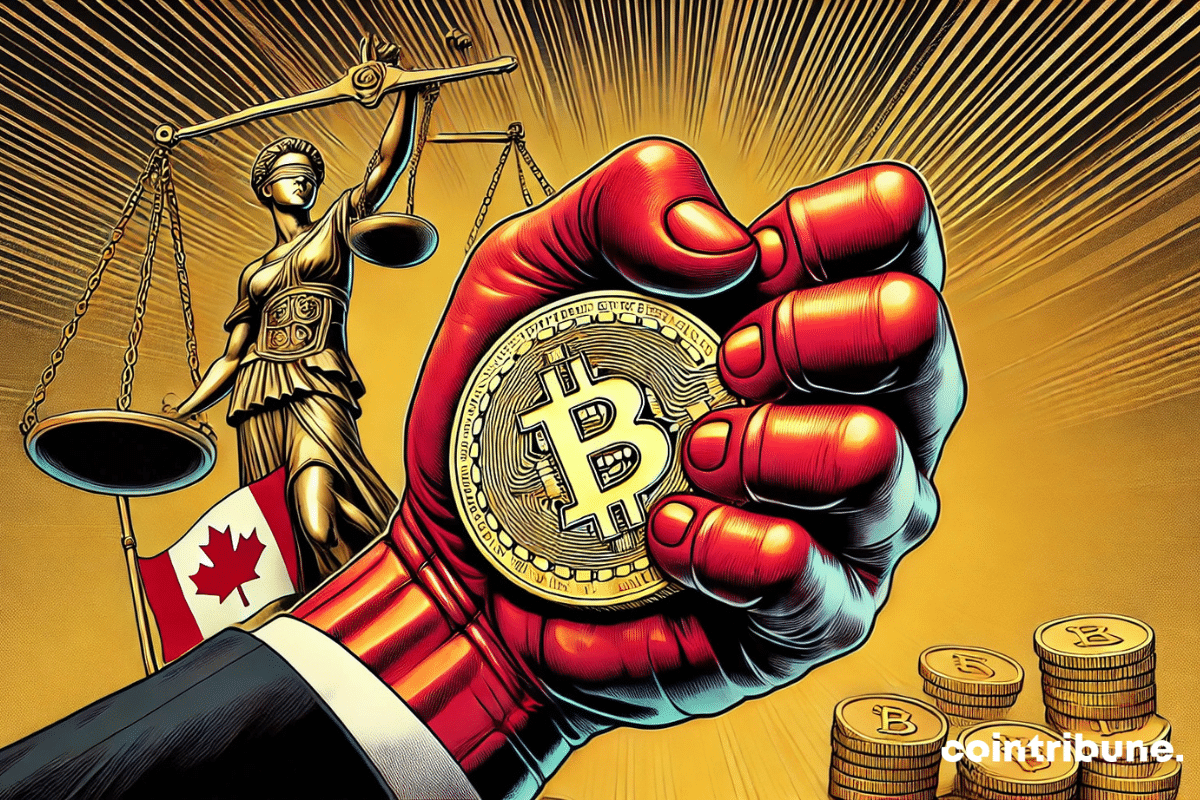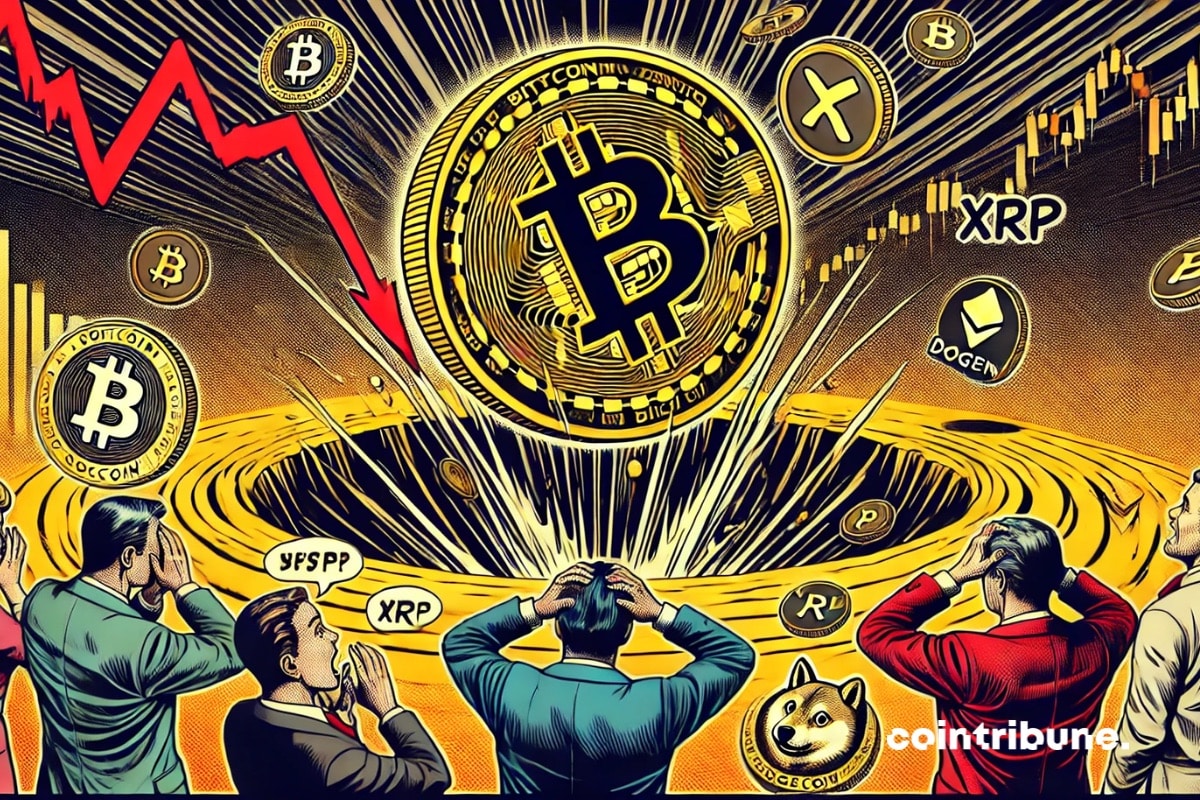And if the disappointing figures of American employment were hiding a backdoor to an unprecedented opportunity for Bitcoin? While the media is mired in economic forecasts, another story is quietly weaving itself: that of a cryptocurrency ready to defy the gravity of traditional markets. Amid frozen expectations from the Fed and surprising legislative advances, Bitcoin positions itself as a mischievous outsider. Ready to leap?
The world of traditional finance is increasingly intertwined with that of Bitcoin, and BlackRock's recent moves only confirm this dynamic. Indeed, the asset management giant, with its $11.6 trillion under management, has just increased its stake in MicroStrategy, now rebranded as Strategy, to 5%. This rise does not go unnoticed: it comes as Strategy continues to accumulate Bitcoin massively, in order to strengthen its role as a pioneer among publicly traded companies. More than just an investment, this strategic alignment raises questions about the future of Bitcoin in institutional portfolios and the place that giants like BlackRock wish to occupy in this rapidly expanding ecosystem.
In an era where artificial intelligence is emerging as an essential strategic lever, France is preparing to host one of the most ambitious projects in Europe: the construction of a campus dedicated to AI supported by the United Arab Emirates. With an announced investment between 30 and 50 billion euros, this initiative represents a significant advance in the international competition for technological sovereignty and computing power. Behind this announcement lies a clear objective: to make France a European hub for artificial intelligence, thanks to cutting-edge infrastructure capable of competing with American and Chinese giants.
The crypto universe remains a legal battleground where technology and law clash mercilessly. Alexey Pertsev, the emblematic figure of the Tornado Cash mixing protocol, has just reached a key milestone: released under electronic surveillance after eighteen months of detention, he is preparing his appeal. A mixed victory. For while the Dutch jails are opening slightly, the Russian developer remains chained to an electronic bracelet, a symbol of freedom under control. His case, much more than a simple judicial fact, embodies the burning tensions between decentralized innovation and legal responsibility.
The social network X, formerly Twitter, is once again under judicial investigation in France. On January 12, Deputy Eric Bothorel alerted the Paris prosecutor's office about the algorithms of Elon Musk's platform, suspected of manipulation. This investigation follows several ongoing legal actions against the platform.
The decentralized application (DApp) market is dominated by gaming and decentralized finance (DeFi), but artificial intelligence (AI) is gaining ground. In January, AI DApps recorded 2.2 million active users, signaling growing adoption. This evolution could shape the future of Web3 and cryptocurrencies.
Crypto market analysts anticipate a significant increase in the price of XRP, the native cryptocurrency of Ripple, due to several ETF (exchange-traded funds) applications currently under review. These initiatives could transform the investment landscape in XRP and attract a substantial influx of institutional capital that could propel XRP up to 1500%!
The United States is ramping up its efforts to regulate dollar-backed stablecoins. A new bill, led by Republican lawmakers, aims to establish a clear regulatory framework. This initiative reflects the desire to strengthen the dominance of the dollar while promoting innovation in the crypto sector.
The rapid rise of AI-backed cryptocurrencies in 2024 heralded a decisive turning point for the convergence between blockchain and AI. Fueled by market euphoria and enthusiasm for agentic AIs, these assets attracted massive capital flows, propelling their valuations to unprecedented heights. However, the enthusiasm evaporated as quickly as it appeared: within just a few months, some of these tokens lost up to 90% of their value. This collapse raises critical questions about the viability of these projects and the strength of the market. Are investors facing a mere correction after a speculative surge, or are we witnessing the beginnings of a lasting disinterest?
Traders fear the impact of the US employment report on bitcoin. In this article, we explain why.
While traditional end-of-reign predictions for Bitcoin were still circulating, the queen of cryptocurrencies responded with a stunning performance: a 125% explosion in options volumes in just one month. Behind this shocking figure, revealed by CCData, lies a deeper reality. Bitcoin is no longer just defying expectations – it is rewriting the investor's manual. Amid institutional plot twists and bold innovations, we dive into a month that shook Wall Street… and beyond.
The Ethereum derivatives markets have just recorded their largest outflow of ETH since August 2023, with over 300,000 ETH withdrawn from exchanges on February 6, 2025. This massive movement, amounting to approximately $817.2 million, comes amid increased market volatility.
On February 6, 2025, the Cboe BZX exchange filed, on behalf of four asset managers, applications for the creation of spot exchange-traded funds (ETFs) based on XRP. The companies involved are Canary Capital, WisdomTree, 21Shares, and Bitwise. These filings mark a significant milestone in the expansion of crypto-related financial products in the United States.
Bitcoin has just experienced an unexpected hiccup: its mining difficulty has decreased for the first time in four months. A fragile breath in an ecosystem accustomed to constant escalation. However, behind this seemingly technical number lies a much more tumultuous story. Amid site closures, rapid updates, and survival strategies, the mining sector is navigating a silent storm. What if this decline were a symptom of a deeper transformation?
The Canadian Investment Regulatory Organization (CIRO) has tightened the noose on cryptocurrencies. On February 5, the regulator excluded crypto funds from reduced margin eligibility, citing their high volatility and liquidity risks.
The crypto market has always been marked by periods of extreme volatility, where panic and opportunities intersect in an instant. Indeed, the recent crash on February 3rd once again illustrated this reality. While XRP plummeted sharply to $1.78, some investors, far from succumbing to panic, seized the opportunity to massively bolster their positions. Among them, Korean traders played a key role. They bought large volumes, allowing XRP to rebound above $2 in record time. But, is this sudden influx of liquidity a sustainable bullish signal or just a temporary reaction from Asian markets?
Holding bitcoin for three years and permanently avoiding capital gains tax? This once-unimaginable scenario is becoming a reality in the Czech Republic. Starting in 2025, cryptocurrency investors will benefit from a full exemption on their capital gains, provided they adhere to a holding period and certain specific rules. This initiative is shaking up the European tax landscape, stirring both the enthusiasm of investors and the questions of experts. What are the stakes of this bold reform? An analysis of a measure with significant implications.
Financial markets have their prophecies, and those of the crypto world are no exception. Indeed, when a $100 billion asset manager like VanEck makes an ambitious prediction such as Solana (SOL) rising to $520 by the end of 2025, the crypto ecosystem stops, observes, and analyzes. Should this be seen as a reliable indicator or an excess of optimism? This announcement is already provoking reactions from investors and analysts. Between technological prospects and market realities, let's revisit this forecast that could reshape the crypto landscape.
Cryptocurrencies continue to divide the academic and financial world. While some see them as an inevitable monetary revolution, others persist in viewing them as a bubble destined to burst. Eugene Fama, a renowned economist and Nobel Prize winner, has thrown a stone into the pond by claiming that Bitcoin is doomed to become worthless. According to him, fundamental economic principles make its long-term survival impossible. A radical prediction that provokes numerous reactions, particularly in a context where BTC continues to be adopted by financial institutions and governments.
Bitcoin maintains its position around 98,000 dollars at the opening of Wall Street on February 6, as analysts closely scrutinize technical indicators to anticipate the next direction of the market.
Rumors about a common BRICS currency frequently resurface, fueling speculation about a possible counterweight to the dollar. As several nations seek to reduce their dependence on the greenback, the prospect of a shared currency raises concerns in the United States. Donald Trump has threatened to impose sanctions on countries considering an alternative. However, the Kremlin has just defused the debate: no such project is under discussion. Instead, the bloc prioritizes joint investment platforms, leaving doubt about its true monetary strategy.
Tesla, once the king of electric roads, sees its empire wobble: Europe turns away, Musk slips, and the competition hits the gas. Is the future without him?
Ethereum continues to face downward pressure, pushing its price lower. Let's analyze the future prospects of ETH.
Sino-American relations continue to deteriorate, pushing China to strengthen its ties with the European Union. Lin Jian, spokesperson for the Chinese Ministry of Foreign Affairs, stated that Beijing sees Europe as a "global strategic partner and an important and independent pillar in a multipolar world."
A new survey by JPMorgan reveals that the majority of institutional investors remain hesitant about cryptocurrencies, despite the improving regulatory framework in the United States. Only 29% of participants are active or plan to engage in this market.









































